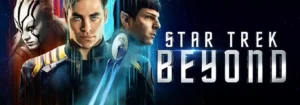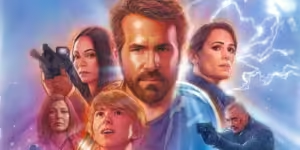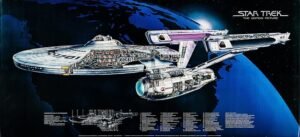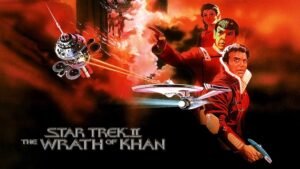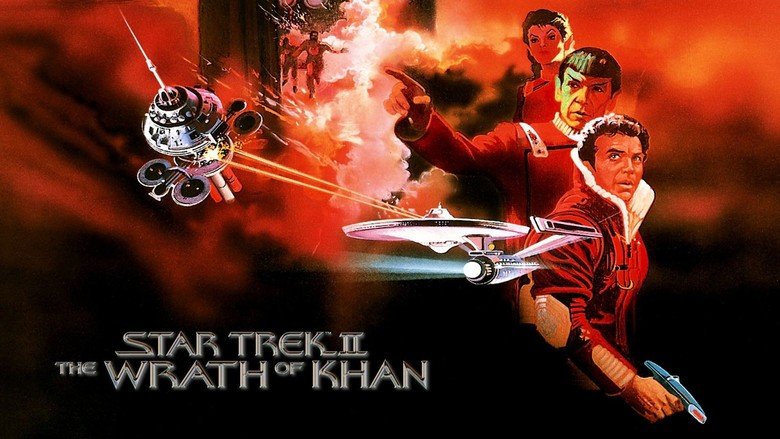
Introduction to Star Trek II: The Wrath of Khan
Released on June 4, 1982, under the direction of Nicholas Meyer, Star Trek II: The Wrath of Khan stands as a pivotal installment within the Star Trek franchise and the broader landscape of science fiction cinema. As the second film in the Star Trek film series, it follows the narrative established by both the original television series and its cinematic predecessor, Star Trek: The Motion Picture (1979). The film has been acclaimed for revitalizing the franchise, engaging both longstanding fans and newcomers through its compelling storyline and character development.
Within the context of the Star Trek universe, The Wrath of Khan reintroduces audiences to the formidable antagonist, Khan Noonien Singh, portrayed by Ricardo Montalbán. Reprising his role from the 1967 television episode “Space Seed,” Montalbán’s performance is often highlighted as one of the film’s defining elements. This film expertly balances action with the philosophical themes that Star Trek is celebrated for, including concepts of friendship, revenge, and the inevitability of change.
The film’s significance extends beyond the Star Trek franchise. Star Trek II: The Wrath of Khan is regarded as a cornerstone of sci-fi cinema, praised for its narrative depth, special effects, and musical score, masterfully composed by James Horner. Critical reception was overwhelmingly positive, with particular commendation directed at its emotionally resonant plot and engaging character arcs. Commercially, the film was a resounding success, grossing nearly $98 million worldwide on a budget of approximately $12 million. Its success not only ensured the continuation of the film series but also solidified its place in the annals of sci-fi history.
In summary, the release and enduring legacy of Star Trek II: The Wrath of Khan underscore its profound impact on both the Star Trek franchise and the genre of science fiction. It remains a beloved and influential work that continues to spark discussion and admiration among audiences and critics alike.
Plot Summary
“Star Trek II: The Wrath of Khan” is a cornerstone of science fiction cinema, distinguished by its compelling narrative and richly developed characters. The storyline revolves around Admiral James T. Kirk, portrayed by William Shatner, facing off against one of his most formidable adversaries, Khan Noonien Singh, played by Ricardo Montalbán. Khan, a genetically engineered superhuman, first appeared in the original “Star Trek” series episode “Space Seed.” Reviving his character in this film, Khan seeks revenge against Kirk for his years of exile on the desolate planet Ceti Alpha V.
The plot thickens as Khan commandeers the USS Reliant, acquiring an experimental device known as the Genesis Device—a powerful piece of technology capable of creating life from lifelessness, but also possessing destructive potential. The Genesis Device serves as a central plot mechanism, driving the narrative’s tension and underscoring the film’s thematic complexity.
Khan’s quest for vengeance transcends mere retribution; it becomes a consuming obsession, emblematic of the overarching themes of vengeance and the catastrophic consequences it can yield. In parallel, Admiral Kirk grapples with his notions of sacrifice and redemption. These elements intertwine skillfully, enriching the storyline with emotional depth and philosophical inquiries about the human condition. The climactic battle between the starships Enterprise and Reliant epitomizes the high stakes and personal vendettas at play.
Notable moments in “Star Trek II: The Wrath of Khan” include the iconic climax where Spock, portrayed by Leonard Nimoy, sacrifices his life to save the Enterprise and his crewmates. This act encapsulates the film’s theme of self-sacrifice, imbuing the narrative with a poignant resonance that has endured with audiences. Ultimately, the film is more than just a tale of good versus evil; it is a meditation on the profound impacts of revenge and the redemptive power of selflessness.
Character Development and Performances
“Star Trek II: The Wrath of Khan” provides an exceptional examination of character development, particularly as it pertains to its leading figures—Captain James T. Kirk, Spock, and the antagonist, Khan Noonien Singh. The film intricately explores the personal growth and evolving complexities of these characters, enriching the narrative depth and engaging the audience on multiple levels. Captain Kirk, portrayed by William Shatner, is depicted grappling with the inevitable passage of time and the responsibilities that accompany his experiences. This isn’t just an action film, but a study of a man coming to terms with his aging self and leadership challenges. Shatner’s performance transcends the realm of a typical science fiction hero, infusing Kirk with vulnerability and introspection, while still retaining his signature charisma and decisiveness.
Spock, brought to life by Leonard Nimoy, is as compelling as ever, merging his logical and human sides masterfully. The character is a paragon of rationality and duty, yet Nimoy ensures that Spock’s internal struggles and loyalties are palpable to the audience. The subtle nuances in Nimoy’s performance allow viewers to perceive the emotional stakes at play, particularly in his interactions with Kirk. Their dynamic, built on mutual respect and deep friendship, becomes a cornerstone of the narrative, offering a poignant exploration of duty and sacrifice.
Meanwhile, Ricardo Montalban’s portrayal of Khan stands as a testament to the power of a well-crafted villain. Khan’s complexity is rooted in his blend of intellect, ruthlessness, and a deeply personal vendetta against Kirk. Montalban imbues Khan with a charismatic menace that commands the screen, presenting a formidable adversary who is both sympathetic and terrifying. The interplay between Kirk and Khan, driving much of the story’s tension, reflects a clash not just of forces but of profoundly different ideologies and histories.
The performances in “Star Trek II: The Wrath of Khan” not only bring added depth to the iconic characters but also highlight the intricate, often adversarial relationships that define the film. Together, Shatner, Nimoy, and Montalban create a tapestry of conflict, loyalty, and growth, underpinning the movie’s lasting appeal and demonstrating why it remains a classic in the science fiction genre.“`
Key Themes and Symbolism
“Star Trek II: The Wrath of Khan” delves into several significant themes that resonate deeply with audiences. One of the foremost is the theme of the consequences of past actions. This is vividly depicted through the antagonist Khan Noonien Singh, whose quest for revenge against Admiral James T. Kirk stems from their earlier encounter in the “Star Trek” television series episode “Space Seed.” The film intricately explores how past decisions shape the present and future, highlighting the inevitability of facing the repercussions of one’s actions.
Friendship and loyalty are central to the narrative, especially within the context of the enduring bond between Admiral Kirk and his crew. The camaraderie and unwavering support they exhibit underscore the strength of their relationships. These themes are embodied in the interactions between Kirk and Spock, whose mutual respect and commitment to each other epitomize the depth of their friendship. The loyalty extends to other crew members as they navigate the challenges posed by Khan’s vengeance.
Mortality, aging, and the passage of time feature prominently in the film, particularly through Admiral Kirk’s character arc. Kirk grapples with his advancing age and the existential reflections that accompany it. This is poignantly juxtaposed with the character of Spock, who faces mortality in a different context. The film’s climax, involving Spock’s self-sacrifice, poignantly addresses the inevitability of death and the meaning of life. Spock’s actions drive home the notion that individual lives are intricately connected to the greater good, reinforcing the thematic undercurrent of duty and sacrifice.
The Genesis Device acts as a potent symbol within the film, representing both creation and destruction. Its dual capacity to generate life and annihilate existing matter metaphorically underscores the film’s exploration of beginnings and endings. This dichotomy resonates with the broader themes of life, death, and rebirth, inviting viewers to reflect on the continuous cycle of existence. Through these rich symbolic elements, “Star Trek II: The Wrath of Khan” offers a profound meditation on human experience, making it a timeless piece of cinematic storytelling.
Visual and Special Effects
Star Trek II: The Wrath of Khan is often celebrated not only for its compelling storytelling but also for its groundbreaking visual and special effects that significantly enhanced the film’s narrative. One of the defining aspects of the movie was its innovative depiction of space battles. The space combat sequences were meticulously crafted, employing a combination of practical effects and early computer-generated imagery (CGI), which delivered a sense of realism and tension. This approach allowed the audience to immerse deeply into the futuristic world of Star Trek, making each confrontation in space both thrilling and visually captivating.
A pivotal moment in the film is the introduction of the Genesis Effect, a revolutionary concept within the Star Trek universe. The Genesis Device’s transformation of a lifeless planet into a habitable world was realized through a combination of advanced CGI and traditional effects. This sequence was not only visually stunning but also carried substantial narrative weight, symbolizing themes of creation and destruction. The Genesis Effect remains one of the most memorable pieces of visual storytelling in the franchise’s history, demonstrating the film’s ability to blend innovative technology with compelling plot elements.
The overall aesthetic of Star Trek II: The Wrath of Khan was carefully designed to complement the film’s darker and more mature themes. The use of practical models, detailed miniatures, and state-of-the-art visual effects techniques at the time contributed to a rich and immersive viewing experience. The film’s ability to balance these elements without overshadowing the core narrative is a testament to its artistic direction and technical prowess.
The film’s special effects were widely recognized and acclaimed. Although it did not win an Academy Award, it received a nomination for Best Visual Effects, affirming its impact within the industry. The recognition underscores the enduring legacy of Star Trek II: The Wrath of Khan in advancing the realm of visual storytelling in science fiction cinema.
Music and Sound Design
The music and sound design of “Star Trek II: The Wrath of Khan” play a crucial role in establishing the film’s lasting appeal. At the heart of this aural experience is the evocative score composed by James Horner. Horner’s work on the film not only accentuates the emotional and dramatic beats, but it also serves as a character in its own right, weaving through the narrative to elevate key moments.
One of the most remarkable aspects of Horner’s score is its ability to enhance the tension and atmosphere throughout the film. From the opening notes of the overture, audiences are drawn into a world where stakes are high and emotions run deep. The score’s dynamic range, featuring both grandiose and subtle cues, ensures that every scene is infused with the appropriate level of intensity. For instance, the use of brass and strings in scenes of confrontation between Captain Kirk and Khan enhances the visceral tension, while softer, more melodic themes underscore the introspective and poignant moments of the film.
Additionally, the soundtrack includes pieces that have become iconic within the “Star Trek” franchise. The use of “Spock’s Theme” is particularly memorable, encapsulating the character’s stoic yet deeply emotional nature. Another standout track is “Battle in the Mutara Nebula,” which perfectly encapsulates the cat-and-mouse game between the two titular characters, using fluctuating tempos and sudden climaxes to mirror the unpredictability and danger of their encounters.
Overall, James Horner’s music for “Star Trek II: The Wrath of Khan” is not merely a background element but a driving force that propels the story forward and enriches the cinematic experience. By deeply intertwining thematic material with the film’s narrative arcs, Horner’s score remains an indelible part of what makes the movie a classic, reinforcing its dramatic tension and emotional depth.
Cultural Impact and Legacy
“Star Trek II: The Wrath of Khan” stands as a seminal work in both the Star Trek franchise and the broader landscape of science fiction. Its release in 1982 revitalized the Star Trek universe, setting a new benchmark for storytelling, character development, and thematic depth. The film’s exploration of vengeance, sacrifice, and the passage of time deeply resonated with audiences, ensuring its place as a fan favorite. It is frequently cited as one of the best, if not the best, films in the franchise, a testament to its enduring appeal.
The influence of “The Wrath of Khan” on future Star Trek media is manifold. It introduced key elements and characters, such as the emergence of the iconic villain, Khan Noonien Singh, who became an indispensable part of the franchise’s lore. The narrative and thematic threads of the film were continued and expanded upon in subsequent movies and series, creating a cohesive and enriched universe that fans have come to cherish. Additionally, the film’s success paved the way for future Star Trek projects, demonstrating that there was a substantial audience for more sophisticated and mature sci-fi narratives.
Beyond Star Trek, “The Wrath of Khan” has left an indelible mark on the science fiction genre as a whole. Its intense character-driven story and moral complexity have inspired countless other sci-fi works, from films to television series and even literature. The film’s influence can be seen in the way it combined high-stakes drama with philosophical inquiries into human nature, a formula that many modern sci-fi creators strive to emulate.
Even decades after its release, “The Wrath of Khan” continues to spark discussions among fans and critics alike. Its memorable dialogue and pivotal scenes are frequently referenced in popular culture, from parodies in television shows to allusions in other films. The film’s ongoing relevance in cultural discourse is a testament to its timeless appeal and the profound impact it has had on both the Star Trek franchise and the science fiction genre at large.
Why You Should Watch Star Trek II: The Wrath of Khan
Star Trek II: The Wrath of Khan stands out as a quintessential film in both the Star Trek franchise and the science fiction genre at large. One of the primary reasons it has maintained its appeal over the years is its compelling story. At its core, the film presents a gripping narrative of revenge, sacrifice, and the complexities of command. The antagonist, Khan Noonien Singh, portrayed by Ricardo Montalbán, is both charismatic and menacing, providing a formidable challenge to Captain James T. Kirk, played by William Shatner. This intense conflict drives the plot forward, keeping viewers on the edge of their seats.
The character arcs in The Wrath of Khan are richly developed, offering depth and emotional resonance. Captain Kirk’s journey is particularly poignant, as he grapples with aging, loss, and his responsibilities as a leader. The film also delves into the profound friendship between Kirk and Spock, adding layers of emotional complexity. These well-crafted character dynamics ensure that the movie resonates with audiences, transcending the typical boundaries of the genre.
Visually, the film was groundbreaking for its time, showcasing impressive special effects that still hold up today. The climactic battle in the Mutara Nebula, with its dramatic lighting and tactical maneuvers, remains one of the most iconic space battles in cinematic history. Such attention to visual details enhances the viewer’s immersion, making the science fiction world appear more vivid and believable.
Beyond its immediate impact, Star Trek II: The Wrath of Khan has left an influential legacy. It firmly established narrative and thematic standards within the Star Trek canon and beyond. Themes of heroism, mortality, and the consequences of one’s actions are explored with a depth that encourages reflection and discussion.
For these reasons, Star Trek II: The Wrath of Khan is not just a movie for fans of the franchise, but a timeless piece of entertainment that continues to engage and inspire both new viewers and seasoned audiences alike. Its narrative strength and thematic profundity make it a must-watch, ensuring its place as a cinematic classic.
